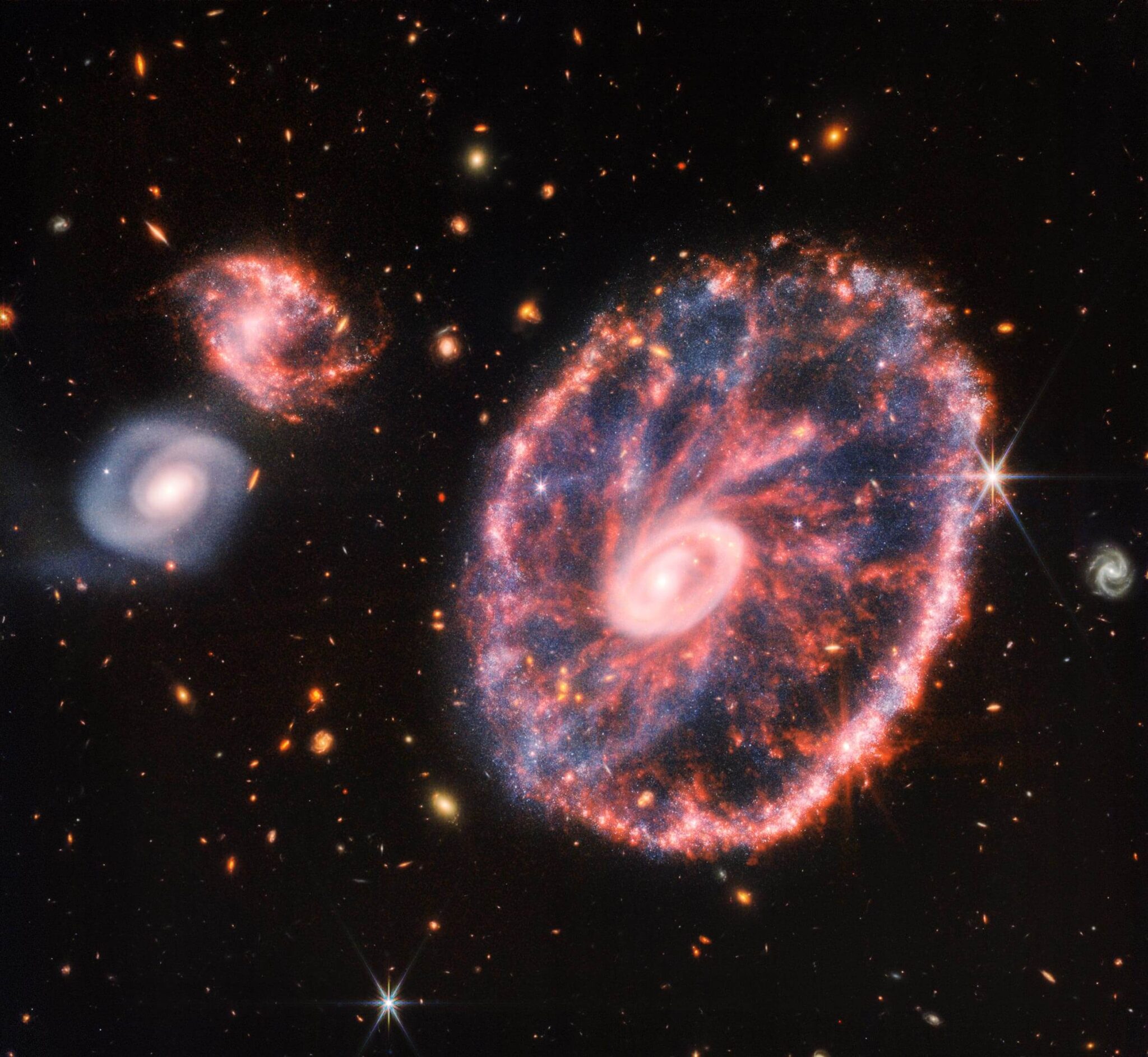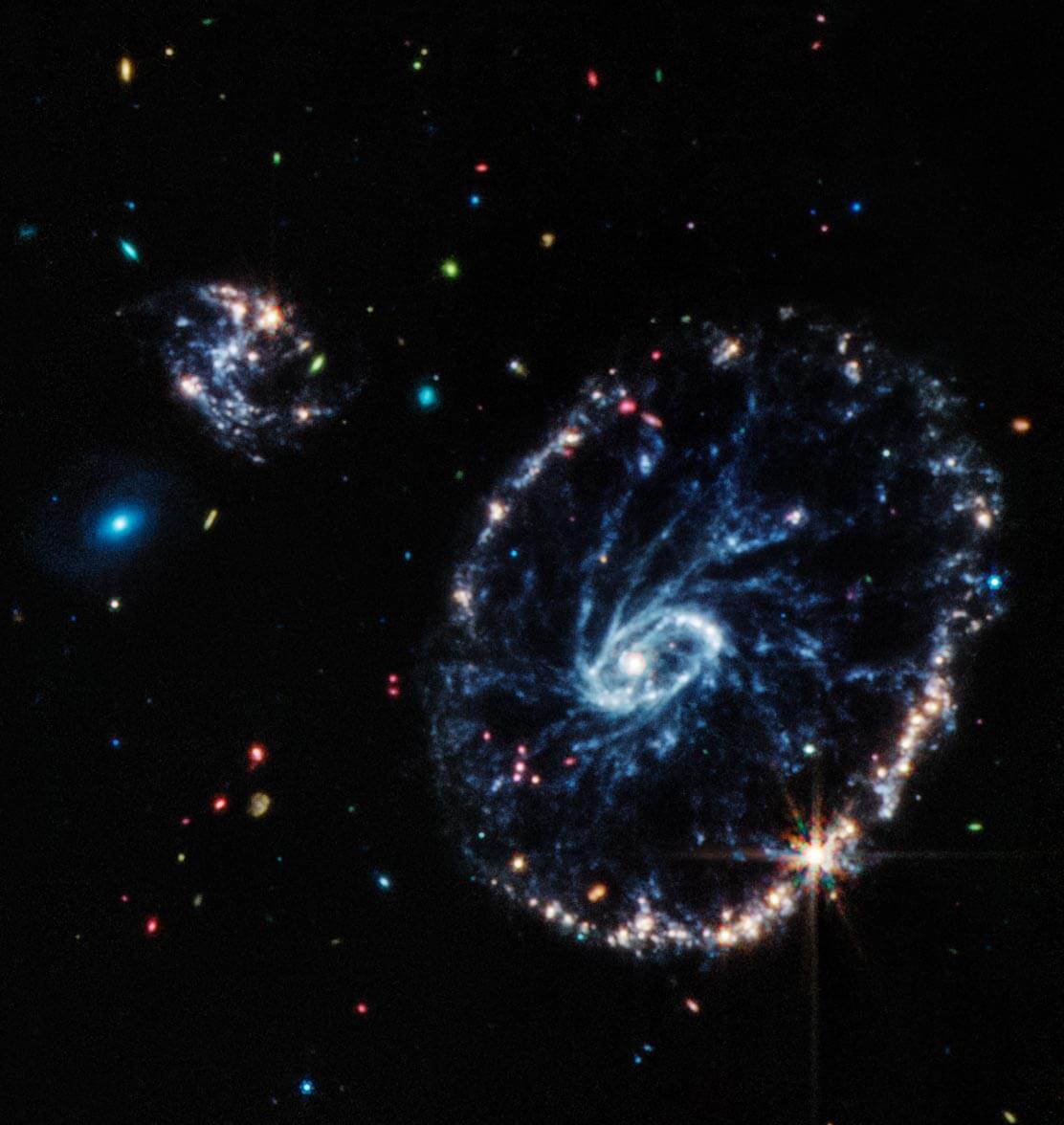Webb's instruments reveal new details about star formation

Webb's instruments reveal new details about star formation
The amazing imaging capabilities of NASA's James Webb Space Telescope have revealed new details about the Wheel Galaxy, a rare ring galaxy that was previously shrouded in dust and mystery.
The galaxy, formed by the collision of a large spiral galaxy with another smaller one, has retained much of its spiral character but has also undergone major changes in its overall structure.
Webb's highly precise instruments separated stars and individual star-forming regions within the galaxy, and also revealed the behavior of the black hole at its center. These new details allow a renewed understanding of a galaxy that is in the midst of slow change.
The James Webb Space Telescope's peek into the chaos of the Pinwheel Galaxy reveals new details about star formation and the black hole at the center of the galaxy. Webb's powerful infrared vision produced this detailed image of the Wheel Galaxy and two smaller companion galaxies with many other galaxies in the background. This new look reveals how the wheel galaxy has changed over billions of years.
The Wheel Galaxy, located about 500 million light-years away in the constellation Psal, is a rare sight. Its appearance, which is very similar to a cart wheel, is the result of a powerful event - a high-speed collision between a large spiral galaxy and a smaller galaxy, which is not visible in this image. Collisions on a galactic scale cause a chain of various events between the galaxies involved, and the Wheel Galaxy is no exception.
The most noticeable effect of the collision was on the shape and structure of the galaxy. The pinwheel galaxy has two rings - a bright inner ring and a colorful outer ring. These two rings spread out from the center of the collision, like ripples in a pond after a stone is thrown in. Because of these distinguishing features astronomers call it a "ring galaxy", a structure less common than spiral galaxies like our Milky Way.
The bright core contains a huge amount of hot dust, with huge clusters of young stars in the brightest regions. On the other hand, in the outer ring, which expanded for about 440 million years, there is mainly the formation of stars and supernovae. As this ring expands, it penetrates the surrounding gas and causes stars to form.
Other telescopes, including the Hubble Space Telescope, have previously examined the pinwheel galaxy, but the dramatic galaxy has been shrouded in mystery – perhaps literally, due to the amount of dust obscuring our view. Webb, with his ability to detect infrared light penetrating the dust clouds, is now revealing new insights into the nature of this galaxy

The James Webb Space Telescope's peek into the chaos of the Pinwheel Galaxy reveals new details about star formation and the black hole at the center of the galaxy. Webb's powerful infrared vision produced this detailed image of the Wheel Galaxy and two smaller companion galaxies with many other galaxies in the background. This new look reveals how the wheel galaxy has changed over billions of years.
The Wheel Galaxy, located about 500 million light-years away in the constellation Psal, is a rare sight. Its appearance, which is very similar to a cart wheel, is the result of a powerful event - a high-speed collision between a large spiral galaxy and a smaller galaxy, which is not visible in this image. Collisions on a galactic scale cause a chain of various events between the galaxies involved, and the Wheel Galaxy is no exception.
The most noticeable effect of the collision was on the shape and structure of the galaxy. The pinwheel galaxy has two rings - a bright inner ring and a colorful outer ring. These two rings spread out from the center of the collision, like ripples in a pond after a stone is thrown in. Because of these distinguishing features astronomers call it a "ring galaxy", a structure less common than spiral galaxies like our Milky Way.
The bright core contains a huge amount of hot dust, with huge clusters of young stars in the brightest regions. On the other hand, in the outer ring, which expanded for about 440 million years, there is mainly the formation of stars and supernovae. As this ring expands, it penetrates the surrounding gas and causes stars to form.
Other telescopes, including the Hubble Space Telescope, have previously examined the pinwheel galaxy, but the dramatic galaxy has been shrouded in mystery – perhaps literally, due to the amount of dust obscuring our view. Webb, with his ability to detect infrared light penetrating the dust clouds, is now revealing new insights into the nature of this galaxy
More of the topic in Hayadan:
- NASA's James Webb Telescope will investigate the beginnings of our solar system
- The Next Thing in Astronomy - Part 1: The James Webb Telescope
- The James Webb Telescope reveals in detail the steamy atmosphere of a distant planet
- The James Webb Telescope sheds light on the evolution of galaxies and black holes in the Stefan quintet
- NASA's Webb Telescope reveals cosmic cliffs and star-forming regions in the Carina Nebula

7 תגובות
It's interesting because there are sure to be other cultures there, in every galaxy there are stars and in every planet there are planets, it's crazy how does this fit with Genesis, God created the heavens and the earth and some snake that talks, there's a little more here than some snake that talks and a man who suddenly discovers that he came naked and didn't have A good alliance is later, come on...
Really interesting. But the problem is that it makes BB's theory more difficult and just helps raise more hypotheses that lack a shred of proof (multiple universes and other myths of scientists. No matter how much you believe in something it still does not become true or close to the truth; see religion entry). The theory of the standard model suffered from difficult questions even before the launch of the Webb telescope (the problem of inflation, etc., the problem of the cosmological constant). So one of the two possibilities (and maybe more possibilities...): the Big Bang did not occur (despite the evidence for it since 1964 and the facts have to be explained differently). The big bang did happen but we currently lack enough information to answer the questions and as of now this is the best existing explanation that is able to explain a large amount of facts visible to our human eyes with a minimum opening for human interpretation - and that, the whole beauty of science.
As I have always argued, modern science advances with the help of observations.
It has barely been operating for over a month and James Webb is already questioning the Big Bang theory. Since we can calculate the distance of a certain galaxy based on redshift, we now have a telescope that can also distinguish in the infrared range (which is not visible to the human eye) and to our surprise we discover that there are incredibly harmonious galaxies that were created before what the theories we have held so far hold.
The big bang theory holds that the bang created 75% hydrogen, 25% helium and sometimes a little bit of lithium. After 300 thousand years the first atoms were formed and 500 million years after that the first stars were formed, and now it turns out that the theory is wrong because Webb was able to locate incredibly organized and ordered galaxies even 13.5 billion years ago or 500 million years after the big bang. So something with the theory just doesn't add up...and this has consequences for the standard model as well.
Are you right? What does it give us that we know there is a galaxy that is 500 million light years away? Who will get there? After all, it is known that the universe is expanding and therefore all the galaxies are moving away from each other at enormous speeds. Therefore the sky will be empty from year to year and we will not see (not in our time) stars (galaxies) and the sky will be dark without light.
The truth must be told - after wasting billions on building the new telescope - the images from 'Web' are identical to the images from 'Hubble'. We haven't advanced a millimeter... and anyway all this space exploration is just... useless... Children's games captivated by the magic of 'Star Wars'... But you don't have the courage to tell the truth...
Did the black holes of the 2 galaxies merge?
Really trying to figure out what it gives? So there are other stars thousands of light years away. Beauty. After all, the human brain has a hard time with infinite numbers, and getting there is not possible, so what is the enthusiasm in all of this (apart from the technological challenge)